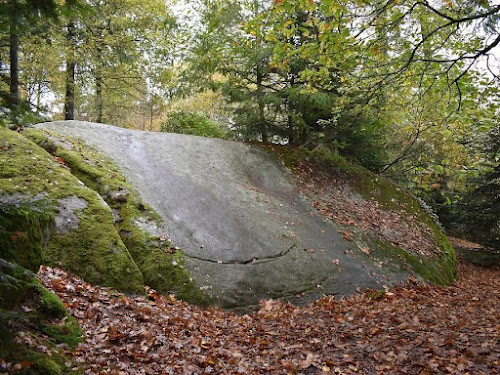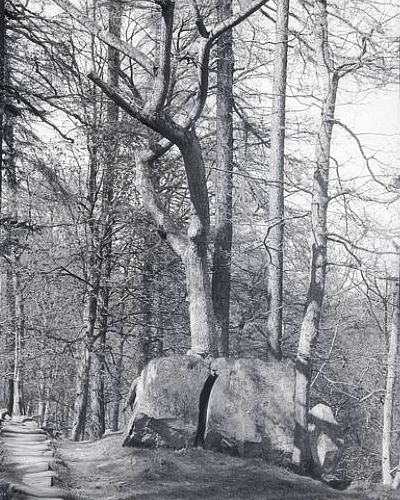Arnecliff Woods are located half a mile to the east of Glaisdale village, on the North York Moors.
A footbridge across the river Esk leads to a woodland path which runs alongside the river, before winding its way up the hillside through the wood. After 500m or so the path passes a large split boulder, which is known locally as the Wishing Stone (grid reference NZ 78625 04964).
The Wishing Stone is not marked on the OS maps, nor does it seem to have been recorded in any local history books. The little information we do have comes from the local author Peter Walker who grew up in Glaisdale, and briefly mentions the rock in his book Folklore of the North York Moors (Walker, 1990). A Google search produced several old images and postcards of the Wishing Stone dating from the early 1900's, but no real details about it. A couple of brief internet references to the stone mention that people would walk around it three (or 9) times whilst making a wish. The second reference says that young women would stand on top of the stone and wish for a good husband. This climbing up onto the rock and wishing for a husband sounds suspiciously like an old fertility practice, which earlier writers may have been reluctant to record. At the Giant's Lapstone in Baysdale, women would climb on top of that boulder to perform an elaborate fertility ritual to ensure an easy birth and healthy children. While a story about another Wishing Stone on Ingleby Greenhow Moor involved women (witches) standing on top of the rock to perform a ritual which involved babies.
These kind of activities fit in with a wider set of fertility beliefs
connected with rocks and boulders that often have cracks, crevices, or
cavities in them. Examples of these 'Fertility Stones' can be found in the
Britain, Europe, and other parts of the world, suggesting a very old and
widespread belief. There may have been an element of symbolism between the
female anatomy and rocks with crevices or cavities in them, however the
rituals performed at some sites suggest a deeper belief behind the practices
(see end note).
In France and Italy there are boulders called Pierre de Fecondite (stone of fertility), Pierre à glissade (slide stone), Roche écriante (Sliding rock), Scivolo Della Fertilità (slide of fertility), Scivolo Delle Donne (slide of the women) etc. These rocks have polished areas on their sloping surfaces, created by people sliding down the rock over many years. Although there was a reluctance to talk about these rock slides in the past, local information revealed that women who wished to have a child, but were having problems conceiving, would slide down these rocks in the hope of curing their infertility. To be effective this sliding or shuffling down the slope of the rock had to be done on their bare bottom so that they were in direct contact with the rock. In Britain there are several examples of these fertility stones, such as a recumbent stone in Holyrood Park (Edinburgh) along which women would slide to cure infertility. A cup and ring marked rock on a farm near Pateley Bridge is actually called the 'Fertility Stone'. The cup marked rock at Ratho (called the Witch's Stone) and the cup marked and split rock at Murthly Farm, Aberfeldy, were both worn smooth by people sliding down their sloping surfaces. Some of these stones were deliberately destroyed in the early 1800's, suggesting that the activities taking place there were frowned upon. Given the personal and delicate nature of these practices, which would be regarded as highly superstitious and unchristian, it is perhaps no surprise that there was a general reluctance to speak about them or reveal their purpose. This may have led to them simply being referred to as "wishing stones", just as some holy wells (originally used for healing purposes) later became known as wishing wells.

|
|
La Pierre Glissante (The Sliding Rock) - note split in rock next to
slide. |
Translation of a poem about La Pierre Glissante (The Sliding Rock) at
Monthault in France.
"I know all the young girls in the region
Who have come to slide for
generations
In secret, thinking of the loved one.
Many have
deposited ribbons
Letting themselves go on my flanks
With a view
to getting married in the year.
Did I hear them?
I cannot reveal
it to you ..."
Following the Monk's Trod
The path through Arnecliff Woods is known as the Monk's Trod, and in
places it is roughly paved with stones worn smooth by the passage of many
feet. A visit to the woods in October 2021 followed the Monks Trod up the
hill, to a level area where the path passes between two large boulders - one
of these being the split rock. The crevice in the rock is around 20cm wide,
and it seems most likely that the block of stone was broken into two parts by
the action of frost and ice. The angular shape of the stone makes it difficult
to climb, but it would certainly be possible to stand on top of the rock to
'wish' for that good husband.
The real 'jaw drop' moment came when standing on top of the adjacent boulder to take a photograph and realising that this second boulder actually has a polished slide down one side of it. This discovery took a few minutes to sink in, and then raised a doubt as to which boulder was the actual Wishing Stone. The split rock is the obvious natural curiosity, but the smooth and polished surface of the rock slide points to that boulder having been the focus of much activity in the past. The rock slide stood out because the green algae on it surface had been removed by someone recently sliding down it several times - probably local children, just as children still use the fertility slides in France and Italy. The sloping surface is very worn and polished, indicating long use as a slide, while a ledge on the side of the boulder aids climbing up onto the rock, unlike the split rock which is difficult to climb.

|
|
Rock slide next to the Arnecliff Wishing Stone |
Given the role of such rock slides in women's fertility rituals in the past, it would seem significant that a polished rock slide exists at the site of the Wishing Stone, where women went to make a wish for a husband (and presumably a father for their children). Perhaps in the past both rocks were part of a folk ceremony, walking around the split rock to wish for a husband, and then mounting the other boulder to slide down its polished surface to promote fertility.

|
|
Tree growing from the Wishing Stone (1902) Image credit Godfrey Bingley |
The old images of the Wishing Stone show that during the late 1800's a quite large tree (apparently an oak) grew up from the crevice on top of the split rock. This would only add to the curious nature (or fertile 'power'?) of the site, where a tree appeared to grow out of solid rock. Today there are the remains of a tree trunk laid alongside the rock, which may be from that tree.
The Wishing Stone and sliding stone are in quite an isolated location, some way from the village. A photo from around 1900 shows the eastern end of the hill without trees, so before the tree planting took place, the two boulders would sits on a terrace half way up the hillside. From here there would be an extensive view up and down the Esk valley, with the river flowing below. The lapstone boulder in Baysdale was located in a similar position but on a smaller scale.
This is another site (like the Wishing Stone on Ingleby Greenhow Moor) where only fragments of folklore survive, but these hint at lost beliefs and folk practices. With no treatment or cure for infertility in the past, people seem to have followed old beliefs involving sympathetic magic and fertility spirits. Childless couples even visited the fertility stones together to 'make a baby', while relatives kept a look out to make sure no one saw them. This secrecy and reluctance to speak about the fertility stones protected the women from any persecution by the church and local authorities, while just making a 'wish' at the stones might have been tolerated.

|
|
The Slide Rock and Wishing Stone 1902 Image credit Godfrey Bingley |
After thoughts
The sliding stones in France hint at the more down to earth and
less romanticised use of these sites. Sliding down the rock bare bottomed must
have been uncomfortable, if not deliberately designed to draw blood. This
hardly seems necessary for someone simply making a wish to be 'married within
the year', and given the fertility nature of these sites, it is perhaps more
likely that the contact with the stone was part of a ritual performed to gain
a blessing of fertility on the marriage, just like the
Lapstone ritual in Baysdale.
At Chevry-en-Sereine in France, the Pied de Femme (the woman's foot) is a fertility rock slide with a foot shaped cavity in the rock. This is worth noting in relation to the foot shaped cavity connected with the fertility ritual at the Lapstone boulder in Baysdale.
In 2015, when the rock art researcher Ulf Bertilsson gave a presentation at Vitlyke museum in Sweden, he heard from a member of the audience who knew two women who had used local rock slides in recent years for fertility reasons, so it seems that in some places the tradition still continues.
End note - What lies within?
At some fertility rock sites where there was a split or crevice
in the rock, women would squeeze through the gap or turn around within it,
making sure their abdomen came into contact with the rock surfaces. These kind
of ritual practices involved some physical discomfort, but also indicate the
seriousness in which they were undertaken, and the belief in the rituals. At
other sites it only required the woman to climb up onto the rock (possibly
sitting or standing astride the crevice?) and recite a charm.
Such beliefs and practices suggest that these particular rocks were believed to have the power to promote fertility or cure infertility? and in some cultures this is attributed to spirits dwelling within the rocks. These beliefs still exist among the indigenous people of America and Australia, who leave offerings for the rock spirits in return for their help and healing powers. Cracks, crevices, hollows and caves etc, are all seen as points where these spirits can enter or leave their dwelling place within the rock. Perhaps the most detailed example of these beliefs can be found among some tribal groups in Australia, where the souls of their unborn children are believed to reside within the rocks at their sacred sites. When a woman first realises she is pregnant they believe the child's soul has come to her at the last sacred site she has been near. When a person dies it is also believed that their spirit returns to those sacred rocks, which form a kind of reservoir for the souls of the tribe.



Post a Comment